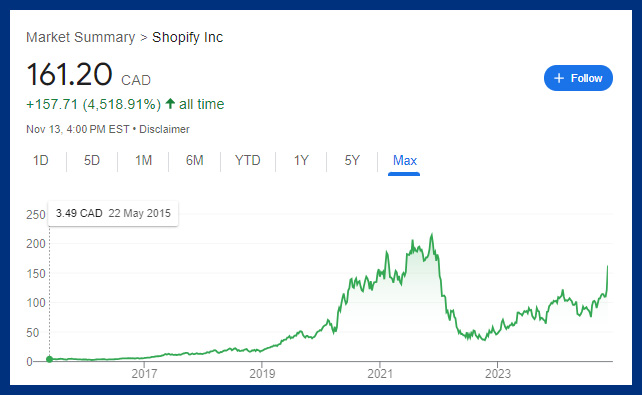Kyle Prevost, creator of 4 Steps to a Worry-Free Retirement, Canada’s DIY retirement planning course, shares financial headlines and offers context for Canadian investors.
The Trump effect
A few things have changed in the world since the last time I wrote a Making Sense of the Markets column a couple of weeks ago. Republican control of all three levels of the American federal government (assuming current vote-counting patterns hold) have sent stocks soaring. This week, the S&P 500 zoomed past 6,000 for the first time, the Dow Jones Industrial Average hit 44,000, and even our very own TSX hit an all-time high of 25,000. It turns out that investors really like the idea of uncontested elections, a lack of insurrections at the White House, and the promise of massive tax reductions.
There are many theories about how president-elect Donald J. Trump’s policy promises will affect the markets around the world. With the massive caveat that many of these campaign promises are unlikely to be fully realized, here’s a brief look at the more prominent market news stories to come out of the election:
With Trump as president, Bitcoin could continue to go through the roof due to manic trading behaviour. Cryptocurrency lobbyists paid more than USD$119 million in order to ensure that Trump will be cheerleading their product(s) “to the moon.” They hope their bribes bets will pay off. Despite making the electric vehicles that Trump once professed to hate, Tesla (TLSA/NASDAQ) shares will go up purely on the basis that CEO Elon Musk has Trump’s ear. Tesla’s share price is up more than 30% since election day. The stock of Trump Media & Technology Group Corp. (DJT/NASDAQ) continued its rise to prominence as the official meme stock of 2024. The company is again worth more than USD$6 billion, despite having no profits—nor any real plan to produce profits in the future.Many Canadian small- and medium-sized businesses are expressing concerns of the 10% to 20% tariff rates, promised by Trump, against all goods produced outside the United States. However, I wouldn’t bet on Canadian oil and natural gas being targeted for tariffs, considering that Trump’s new National Security Advisor is married to the vice president for TC Energy Corp.
One could also argue the overall effect of a roaring deficit-fuelled U.S. economy (full of supercharged consumers who buy Canadian goods) could balance out the tariff threat, as far as the overall Canadian economy goes. But the same case can’t be made for many countries in Asia.
Andrew Tilton, Goldman’s chief Asia-Pacific economist, recently highlighted Korea, Taiwan and Vietnam as countries that could be most drastically affected, in addition to Trump’s favourite tariff target, China.
I personally think if there’s one thing we’ve learned from elections around the world this year, it is that most people have no idea how inflation works—and that they really really hate the cost of things right now. Those strong voter emotions will likely place an inflation-supported ceiling on just how high Trump can push his tariff agenda.
While “tariff” might very well be Trump’s favourite word, but “inflation” isn’t likely on his radar. The Tax Policy Center and Peterson Institute for International Economics predicts that the typical U.S. household would pay almost $3,000 more per year if he enacted a 20% worldwide tariff, combined with a 60% tariff on Chinese goods.
Of course, it’s worth pointing out that all this information was likely priced into the market in the days following the election. So if you’re planning to capitalize on the “Trump Trade,” you’re almost assuredly late to the party.
Read more:
What does Trump’s election mean for the Canadian economy? How Trump’s election win could affect interest rates in Canada Price of bitcoin hits new high after Trump victory, and more crypto newsBig earnings day for Shopify
Shares of Ottawa-based Shopify Inc. were up 21.5% last Tuesday (and about 30% over the last five business days, finishing Thursday at $153.43). Earnings came in stronger than the market predicted and future guidance showed a strong positive upward trend.
Shopify’s earning highlights
Here’s what came out of the earnings report from Canada’s multinational e-commerce company. Shopify reports in U.S. dollars due to its dual listing on both the Toronto and New York stock exchanges.
• Shopify (SHOP/TSX): Earnings per share of USD$0.26 (versus $0.20 predicted), and revenues of USD$2.04 (versus $2.01 predicted).
Shopify catapulted itself back into the spot as Canada’s second largest company, with a market cap of about $148 billion (behind RBC’s $175 billion but ahead of TD’s $98 billion). If you take Constellation Software out of the mix, Shopify would be bigger than all of Canada’s tech companies put together. (If you want to efficiently invest in Canada’s relatively small tech sector, the XIT ETF may be worth considering.)
 Source: Google Finance
Source: Google Finance
Shopify’s increased guidance and earnings beat were chiefly due to the company’s international expansion and increased offering and use of its AI tools. Shopify is one of the first companies we’ve seen to actually get specific about how AI is being used to raise profits. By providing clients with tools like Shopify Flow to automotive inventory management, Shopify increases their value proposition to businesses of all sizes.
Shopify’s quarterly revenue was up 26% year over year. Morningstar analyst Dan Romanoff stated, “Shopify should build on success in attracting larger brands to the platform, especially given the rash of recently launched features and products, including Markets Pro, Shopify Magic and Commerce Components. GMV [Gross Merchandise Value] accelerated to 24% year-over-year growth to USD$69.7 billion, while gross payment volume processed through Shopify Payments was USD $42.9 billion, or 62% of GMV.”
Shopify will have to continue its rapid revenue growth if it is going to grow into its current valuation. With its price-to-earnings P/E ratio currently at about 120x, the rollercoaster ride for this stock may not be done.
Read: Shopify share price soars after Q3 earnings beat
Canada’s best dividend stocks
Canadian Fossil Fuel majors improve earnings
While the focus this past week was on American energy, Canadian fossil fuel companies were hard at work as well.
Canadian energy earnings highlights
Suncor and Keyera reported this week.
Suncor Energy Inc. (SU/TSX): Earnings per share of $1.48 (versus $1.12 predicted), and revenue of $13.06 billion (versus $13.00 billion estimate). Keyera (KEY/TSX): Earnings per share of $0.81 (versus $0.58 predicted), and revenues of $1.73 billion (versus $1.76 billion predicted).Suncor shareholders must be pleased with CEO Rich Kruger’s focus on efficiency, since he began at the company last April. That efficiency led to an excellent quarter, and the share price was up 5% on Tuesday when earnings were announced. Earnings increased to $2.02 billion from $1.54 billion year over year.
Kruger was happy to inform shareholders: “This is now back to back to back quarterly records.”
Suncor took those increased earnings and used some of it to pay off $1.4 billion of its debt. The company also gave shareholders $1.5 billion through share buybacks and dividends. The big takeaway from the earnings call, though, was that since Suncor has now hit its debt target and subsequently, it will be returning 100% of excess funds to shareholders (previously it was currently returning 50% of excess funds). That should obviously result in substantially more share buybacks and dividend increases in years to come, assuming the price of oil remains relatively stable.
Suncor needs the West Texas Intermediate (WTI) crude oil price to stay at about $45 per barrel to break even. The price has been in the $60-to-$105 range since the depths of the pandemic crash. That said, there’s speculation that Organization of the Petroleum Exporting Countries (OPEC) increasing production, combined with Trump’s “drill baby drill” philosophy, could lead to $40 oil before the end of 2025.
Canadian pipelines often report earnings slightly different than how other companies do. They tend to focus on free cashflow numbers. Consequently, Keyera’s large earnings beat wasn’t particularly important to investors, and the share price was down about 1% on Thursday after earnings were announced. Debt-to-earnings is now at 1.9 times, substantially below the 2.5 times to three times that the company normally targets. The financial flexibility built upon the moderate debt load allowed Keyera to announce a 4% increase to its dividend.
Read more about Suncor’s dividend boost. And see how Keyera stacks up against its competitors by reading about my picks for best Canadian pipeline stocks at MillionDollarJourney.com.
Canadians are looking for cheaper groceries
Three Canadian blue-chip companies had mediocre earnings days this week, with no major surprises to the upside or downside.
Canadian earnings highlights
More earnings from the week:
Loblaw Companies Ltd. (L/TSX): Earnings per share of $2.50 (versus $2.46 predicted), and revenues of $18.54 billion (versus $18.64 billion predicted). Canadian Utilities (CU/TSX): Earnings per share of $0.43 (versus $0.41 predicted), and revenues of $860 million (versus $935 million predicted). Power Corporation of Canada (POW/TSX): Earnings per share of $0.84 (versus $1.09 predicted). Revenue information was not provided by the company.Loblaw shares fell 2.4% on Wednesday after announcing earnings. The shift to discount stores like its No Frills and Maxi stores (and away from its higher-profit retailers) meant decreased overall profitability. Loblaws will be focusing on discount store growth in the immediate future, with a pilot No Name store planned.
Power Corp shares were down nearly 4% on Wednesday, thanks to the earnings miss. Earnings from operations were down by roughly 50% year over year.
Canadian Utilities shares were up slightly on Thursday after a mixed earnings report.
The Canadian stock market also saw an interesting initial public offering this week, with the $2.3 billion IPO launch for women’s clothing retailer Groupe Dynamite Inc., which may be more well known by its store brands Garage and Dynamite. Owner and CEO Andrew Lutfy will retain 87% of the company. Group Dynamite will trade on the Toronto Stock Exchange under the symbol GRGD.
The best ETFs in Canada
More about investing:
Boost your portfolio: Why and how to increase small-cap exposure with ETFs WeBull Canada review Best robo-advisors in Canada Scared of selling? When holding on to stocks can hurt you financially Gemini is exiting the Canadian market, plus more crypto newsThe post Making sense of the markets this week: November 17, 2024 appeared first on MoneySense.












 Bengali (Bangladesh) ·
Bengali (Bangladesh) ·  English (United States) ·
English (United States) ·